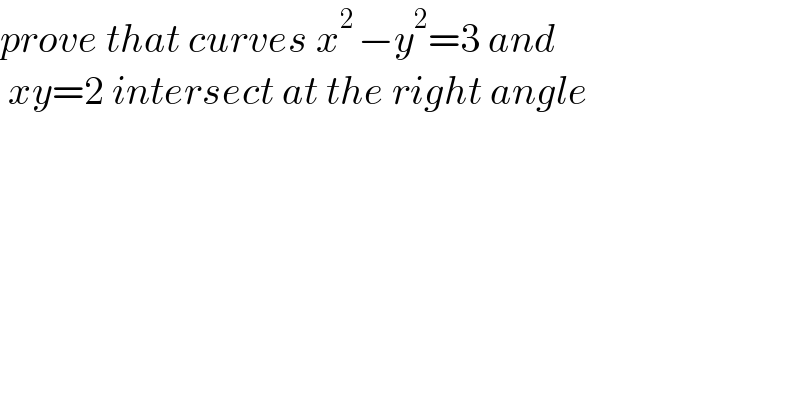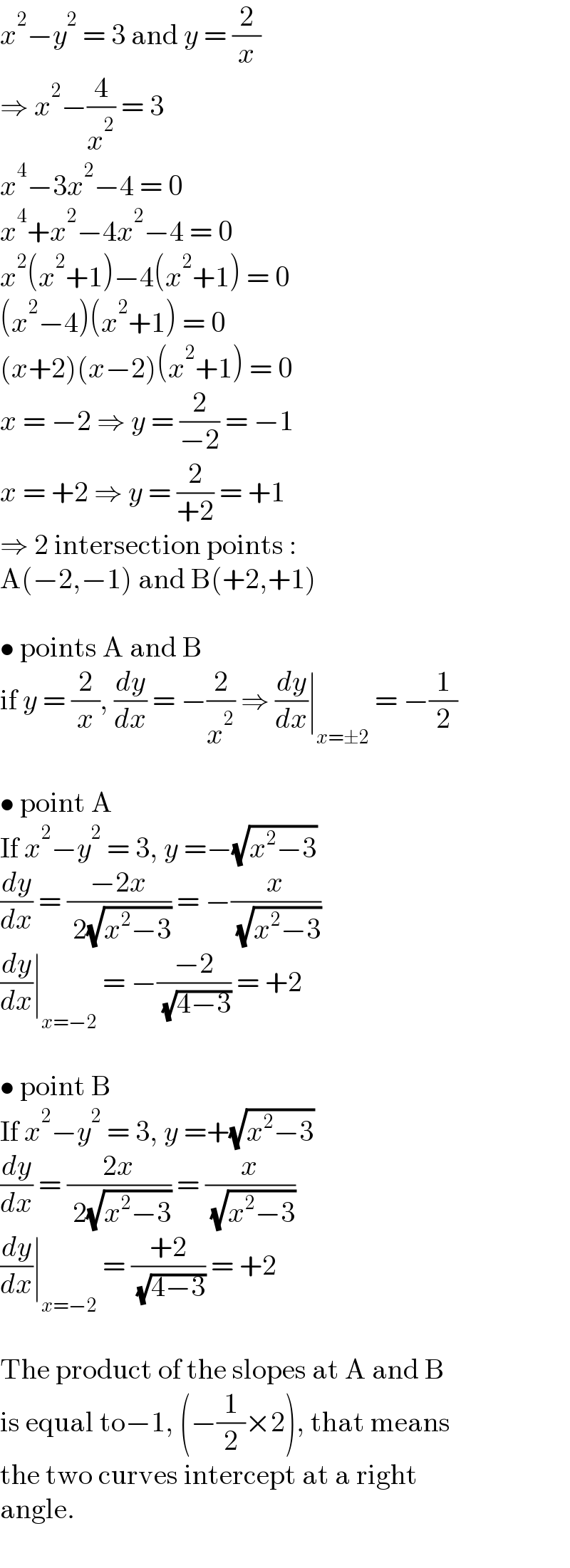Question Number 147748 by Odhiambojr last updated on 23/Jul/21

$${prove}\:{that}\:{curves}\:{x}^{\mathrm{2}\:} −{y}^{\mathrm{2}} =\mathrm{3}\:{and} \\ $$$$\:{xy}=\mathrm{2}\:{intersect}\:{at}\:{the}\:{right}\:{angle}\: \\ $$$$ \\ $$
Commented by Olaf_Thorendsen last updated on 23/Jul/21

$${x}^{\mathrm{2}} −{y}^{\mathrm{2}} \:=\:\mathrm{3}\:\mathrm{and}\:{y}\:=\:\frac{\mathrm{2}}{{x}} \\ $$$$\Rightarrow\:{x}^{\mathrm{2}} −\frac{\mathrm{4}}{{x}^{\mathrm{2}} }\:=\:\mathrm{3} \\ $$$${x}^{\mathrm{4}} −\mathrm{3}{x}^{\mathrm{2}} −\mathrm{4}\:=\:\mathrm{0} \\ $$$${x}^{\mathrm{4}} +{x}^{\mathrm{2}} −\mathrm{4}{x}^{\mathrm{2}} −\mathrm{4}\:=\:\mathrm{0} \\ $$$${x}^{\mathrm{2}} \left({x}^{\mathrm{2}} +\mathrm{1}\right)−\mathrm{4}\left({x}^{\mathrm{2}} +\mathrm{1}\right)\:=\:\mathrm{0} \\ $$$$\left({x}^{\mathrm{2}} −\mathrm{4}\right)\left({x}^{\mathrm{2}} +\mathrm{1}\right)\:=\:\mathrm{0} \\ $$$$\left({x}+\mathrm{2}\right)\left({x}−\mathrm{2}\right)\left({x}^{\mathrm{2}} +\mathrm{1}\right)\:=\:\mathrm{0} \\ $$$${x}\:=\:−\mathrm{2}\:\Rightarrow\:{y}\:=\:\frac{\mathrm{2}}{−\mathrm{2}}\:=\:−\mathrm{1} \\ $$$${x}\:=\:+\mathrm{2}\:\Rightarrow\:{y}\:=\:\frac{\mathrm{2}}{+\mathrm{2}}\:=\:+\mathrm{1} \\ $$$$\Rightarrow\:\mathrm{2}\:\mathrm{intersection}\:\mathrm{points}\:: \\ $$$$\mathrm{A}\left(−\mathrm{2},−\mathrm{1}\right)\:\mathrm{and}\:\mathrm{B}\left(+\mathrm{2},+\mathrm{1}\right) \\ $$$$ \\ $$$$\bullet\:\mathrm{points}\:\mathrm{A}\:\mathrm{and}\:\mathrm{B} \\ $$$$\mathrm{if}\:{y}\:=\:\frac{\mathrm{2}}{{x}},\:\frac{{dy}}{{dx}}\:=\:−\frac{\mathrm{2}}{{x}^{\mathrm{2}} }\:\Rightarrow\:\frac{{dy}}{{dx}}\mid_{{x}=\pm\mathrm{2}} \:=\:−\frac{\mathrm{1}}{\mathrm{2}} \\ $$$$ \\ $$$$\bullet\:\mathrm{point}\:\mathrm{A} \\ $$$$\mathrm{If}\:{x}^{\mathrm{2}} −{y}^{\mathrm{2}} \:=\:\mathrm{3},\:{y}\:=−\sqrt{{x}^{\mathrm{2}} −\mathrm{3}} \\ $$$$\frac{{dy}}{{dx}}\:=\:\frac{−\mathrm{2}{x}}{\:\mathrm{2}\sqrt{{x}^{\mathrm{2}} −\mathrm{3}}}\:=\:−\frac{{x}}{\:\sqrt{{x}^{\mathrm{2}} −\mathrm{3}}} \\ $$$$\frac{{dy}}{{dx}}\mid_{{x}=−\mathrm{2}} \:=\:−\frac{−\mathrm{2}}{\:\sqrt{\mathrm{4}−\mathrm{3}}}\:=\:+\mathrm{2} \\ $$$$ \\ $$$$\bullet\:\mathrm{point}\:\mathrm{B} \\ $$$$\mathrm{If}\:{x}^{\mathrm{2}} −{y}^{\mathrm{2}} \:=\:\mathrm{3},\:{y}\:=+\sqrt{{x}^{\mathrm{2}} −\mathrm{3}} \\ $$$$\frac{{dy}}{{dx}}\:=\:\frac{\mathrm{2}{x}}{\:\mathrm{2}\sqrt{{x}^{\mathrm{2}} −\mathrm{3}}}\:=\:\frac{{x}}{\:\sqrt{{x}^{\mathrm{2}} −\mathrm{3}}} \\ $$$$\frac{{dy}}{{dx}}\mid_{{x}=−\mathrm{2}} \:=\:\frac{+\mathrm{2}}{\:\sqrt{\mathrm{4}−\mathrm{3}}}\:=\:+\mathrm{2} \\ $$$$ \\ $$$$\mathrm{The}\:\mathrm{product}\:\mathrm{of}\:\mathrm{the}\:\mathrm{slopes}\:\mathrm{at}\:\mathrm{A}\:\mathrm{and}\:\mathrm{B} \\ $$$$\mathrm{is}\:\mathrm{equal}\:\mathrm{to}−\mathrm{1},\:\left(−\frac{\mathrm{1}}{\mathrm{2}}×\mathrm{2}\right),\:\mathrm{that}\:\mathrm{means} \\ $$$$\mathrm{the}\:\mathrm{two}\:\mathrm{curves}\:\mathrm{intercept}\:\mathrm{at}\:\mathrm{a}\:\mathrm{right} \\ $$$$\mathrm{angle}. \\ $$
Answered by iloveisrael last updated on 23/Jul/21

$$\left(\mathrm{1}\right)\mathrm{x}^{\mathrm{2}} −\mathrm{y}^{\mathrm{2}} =\mathrm{3} \\ $$$$\Rightarrow\mathrm{2x}−\mathrm{2y}.\mathrm{y}'=\mathrm{0} \\ $$$$\Rightarrow\mathrm{m}_{\mathrm{1}} =\:\mathrm{y}'=\frac{\mathrm{x}}{\mathrm{y}} \\ $$$$\left(\mathrm{2}\right)\mathrm{xy}=\mathrm{2} \\ $$$$\Rightarrow\mathrm{y}+\mathrm{xy}'=\mathrm{0}\: \\ $$$$\Rightarrow\mathrm{m}_{\mathrm{2}} =\:\mathrm{y}'=−\frac{\mathrm{y}}{\mathrm{x}} \\ $$$$\therefore\:\mathrm{m}_{\mathrm{1}} ×\mathrm{m}_{\mathrm{2}} =−\mathrm{1}\: \\ $$
